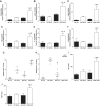Overactivation of intestinal sterol response element-binding protein 2 promotes diet-induced nonalcoholic steatohepatitis
- PMID: 28774869
- PMCID: PMC5792218
- DOI: 10.1152/ajpgi.00174.2017
Overactivation of intestinal sterol response element-binding protein 2 promotes diet-induced nonalcoholic steatohepatitis
Abstract
Nonalcoholic fatty liver disease (NAFLD) is characterized by lipid accumulation in the liver that may progress to hepatic fibrosis and nonalcoholic steatohepatitis (NASH). Mechanisms underlying NAFLD and NASH are not yet fully understood. Dietary cholesterol was recently shown to be a risk factor for the development of NASH, suggesting a role for intestinal handling of cholesterol. One important regulator of cholesterol homeostasis is the sterol response element-binding protein-2 (SREBP-2) transcription factor. We tested the hypothesis that the overactivation of intestinal SREBP-2 increases the susceptibility to diet-induced NASH. A transgenic mouse model with intestine-specific overexpression of active SREBP-2 (ISR2 mice) driven by villin promoter was used. ISR2 mice and their wild-type littermates were fed a regular chow diet or a high-fat, high-cholesterol (HFHC) diet (15% fat, 1% cholesterol) for 15 wk. Results showed that HFHC feeding to ISR2 mice caused hepatic inflammation with increased levels of proinflammatory cytokines. Histological examination demonstrated extensive fibrosis after a HFHC diet associated with a perivascular as well as pericellular collagen deposits in ISR2 mice compared with wild-type littermates. The severe hepatic inflammation and advanced fibrosis in ISR2 mice was not associated with a difference in lipid accumulation in ISR2 mice compared with wild type littermates after HFHC feeding. These data indicate that overactivation of intestinal SREBP2 promotes diet-induced hepatic inflammation with features of human NASH resulting in rapid severe fibrosis and provide a novel link between regulatory processes of intestinal cholesterol and progression of fatty liver.NEW & NOTEWORTHY The current study highlights the role of overactivation of intestinal SREBP-2 transcription factor in the progression of hepatic fibrosis associated with diet-induced NASH. Mice with intestine-specific overexpression of SREBP-2 demonstrated more inflammation and severe fibrosis in the liver in response to 15 wk of being fed a high-cholesterol, high-fat diet as compared with their wild-type littermates. These data demonstrate a novel link between intestinal regulatory processes of cholesterol metabolism and the pathogenesis of fatty liver diseases.
Keywords: ISR2 mice; high cholesterol; high fat; intestinal sterol response element-binding protein 2; liver fibrosis; nonalcoholic fatty liver disease; nonalcoholic steatohepatitis.
Figures






Similar articles
-
Comparison of murine steatohepatitis models identifies a dietary intervention with robust fibrosis, ductular reaction, and rapid progression to cirrhosis and cancer.Am J Physiol Gastrointest Liver Physiol. 2020 Jan 1;318(1):G174-G188. doi: 10.1152/ajpgi.00041.2019. Epub 2019 Oct 21. Am J Physiol Gastrointest Liver Physiol. 2020. PMID: 31630534 Free PMC article.
-
Loss of SREBP-1c ameliorates iron-induced liver fibrosis by decreasing lipocalin-2.Exp Mol Med. 2024 Apr;56(4):1001-1012. doi: 10.1038/s12276-024-01213-2. Epub 2024 Apr 16. Exp Mol Med. 2024. PMID: 38622198 Free PMC article.
-
Liraglutide improves hepatic steatosis and metabolic dysfunctions in a 3-week dietary mouse model of nonalcoholic steatohepatitis.Am J Physiol Gastrointest Liver Physiol. 2019 Oct 1;317(4):G508-G517. doi: 10.1152/ajpgi.00139.2019. Epub 2019 Aug 28. Am J Physiol Gastrointest Liver Physiol. 2019. PMID: 31460789
-
Nonalcoholic Fatty Liver Disease and Staging of Hepatic Fibrosis.Adv Exp Med Biol. 2024;1460:539-574. doi: 10.1007/978-3-031-63657-8_18. Adv Exp Med Biol. 2024. PMID: 39287864 Review.
-
Galectin-3 and IL-33/ST2 axis roles and interplay in diet-induced steatohepatitis.World J Gastroenterol. 2016 Nov 28;22(44):9706-9717. doi: 10.3748/wjg.v22.i44.9706. World J Gastroenterol. 2016. PMID: 27956794 Free PMC article. Review.
Cited by
-
Dietary cholesterol does not break your heart but kills your liver.Porto Biomed J. 2019 Jun 29;3(1):e12. doi: 10.1016/j.pbj.0000000000000012. eCollection 2018 Aug. Porto Biomed J. 2019. PMID: 31595236 Free PMC article. Review.
-
Elucidating Potential Profibrotic Mechanisms of Emerging Biomarkers for Early Prognosis of Hepatic Fibrosis.Int J Mol Sci. 2020 Jul 3;21(13):4737. doi: 10.3390/ijms21134737. Int J Mol Sci. 2020. PMID: 32635162 Free PMC article. Review.
-
Srebf2 Locus Overexpression Reduces Body Weight, Total Cholesterol and Glucose Levels in Mice Fed with Two Different Diets.Nutrients. 2020 Oct 14;12(10):3130. doi: 10.3390/nu12103130. Nutrients. 2020. PMID: 33066385 Free PMC article.
-
Disturbances in Cholesterol Homeostasis and Non-alcoholic Fatty Liver Diseases.Front Med (Lausanne). 2020 Sep 2;7:467. doi: 10.3389/fmed.2020.00467. eCollection 2020. Front Med (Lausanne). 2020. PMID: 32984364 Free PMC article. Review.
-
Mechanism and therapeutic potential of liver injury induced by cholesterol-associated proteins.Front Pharmacol. 2025 Mar 27;16:1572592. doi: 10.3389/fphar.2025.1572592. eCollection 2025. Front Pharmacol. 2025. PMID: 40213681 Free PMC article. Review.
References
-
- Asgharpour A, Cazanave SC, Pacana T, Seneshaw M, Vincent R, Banini BA, Kumar DP, Daita K, Min HK, Mirshahi F, Bedossa P, Sun X, Hoshida Y, Koduru SV, Contaifer D Jr, Warncke UO, Wijesinghe DS, Sanyal AJ. A diet-induced animal model of non-alcoholic fatty liver disease and hepatocellular cancer. J Hepatol 65: 579–588, 2016. doi:10.1016/j.jhep.2016.05.005. - DOI - PMC - PubMed
-
- Boursier J, Mueller O, Barret M, Machado M, Fizanne L, Araujo-Perez F, Guy CD, Seed PC, Rawls JF, David LA, Hunault G, Oberti F, Calès P, Diehl AM. The severity of nonalcoholic fatty liver disease is associated with gut dysbiosis and shift in The metabolic function of the gut microbiota. Hepatology 63: 764–775, 2016. doi:10.1002/hep.28356. - DOI - PMC - PubMed
MeSH terms
Substances
Grants and funding
LinkOut - more resources
Full Text Sources
Other Literature Sources
Medical
Molecular Biology Databases

